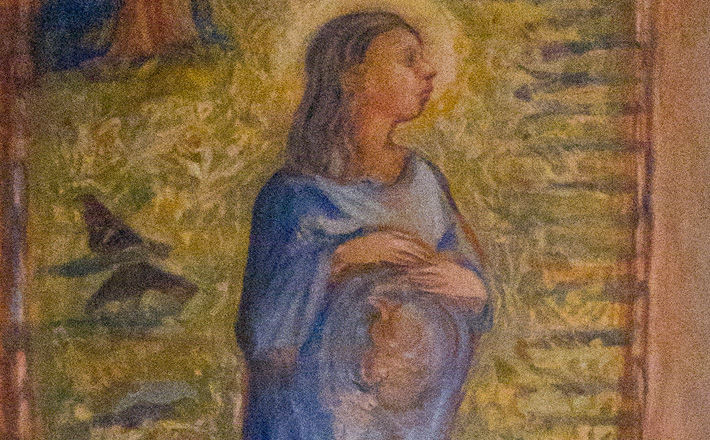Commentary on Matthew 1:18-25
Strictly speaking, the Fourth Sunday of Advent is the last Sunday in the season of preparation for celebrating the first advent (coming) and anticipating the second advent (apocalypse, second coming).
However, some congregations effectively regard today as “Christmas Sunday.” While liturgical purists bemoan this development, it has something to commend it. The worshipping community that gathers on the Fourth Sunday of Advent is likely made up primarily of the local congregation whereas on Christmas Eve and Day, the worshipping community includes many visitors, while many regulars are themselves visiting elsewhere.
Matthew 1:18-25, like the rest of Matthew’s Gospel, is intended to address the congregation as people who are bound together for long-term life and witness. Of course, others can benefit, but “Christmas Sunday” affords the congregation an opportunity to consider the birth of Jesus as community. From this point of view, the story has several dimensions. The preacher might develop one of them, or might find a way to bring several into the sermon.
The story reveals the identity of Jesus. Matthew introduces the birth of Jesus with the genealogy (Matthew 1:1-17). The names in the genealogy are arranged in symbolic sets of 14 (a multiple of seven), thereby signaling that Jesus is the Messiah, through whom God will bring about the manifestation of the Realm of God. The birth of Jesus, for Matthew, is thus an apocalyptic event, the first step in the transition from the old age to the new. The congregation is first and foremost a community of the new age whose purpose is to point to the new in the midst of the old.
The story establishes an important credential of Jesus. A number of communities in the ancient world used remarkable birth stories to show that an important person was under the divine hand from the beginning. Matthew explicitly says that Mary was a virgin (parthenos) when Jesus was born. This unusual dimension of Jesus’ birth indicates that God has had a hand in Jesus’ life from the very beginning.
Listeners, therefore, can trust that Jesus represents the reign of God, and can see God’s apocalyptic purposes in his teaching, actions, death, and resurrection. The preacher might ask, “What qualities would people today find authenticating about Jesus and the church?” Given increasing non-interest in the church in the larger world, and even the disdain of the church in many places today, this question is important.
The story alerts the reader to the presence of the Spirit animating Jesus’ birth, preparing the reader to recognize the Spirit animating the work of Jesus’ ministry and extending to animate the ministries of the later Matthean community. The immersion of Jesus not only publicly demonstrates that the eschatological Spirit is in Jesus but that event is a model for those who come into the community of Jesus (Matthew 3:11, 16). Just as the Spirit is with Jesus in the temptation, so the Spirit is with Jesus’ followers when they are tempted to turn away from the way of the Realm and in other life settings (Matthew 4:1; 10:20; 18:16-20).
Just as the Spirit is manifest through an itinerant rabbi repeatedly in conflict with some of the respected leaders of his own community, who was murdered, and whose last words instructed the disciples to welcome Gentiles into the eschatological community — the picture of the Spirit stirring life in the womb of an unmarried peasant is a paradigm of the Spirit manifesting the Realm of God in circumstances that end-time thinkers might not ordinarily expect.
The story indicates how Matthew wants people to respond to the message of the Realm. Mary and Joseph were betrothed, not yet fully married. Neither party in a coming marriage could have sexual relations with an outside person. Mary’s pregnancy catches Joseph by surprise. According to Deuteronomy 22:23-27, Mary could be tried publicly and then executed. By resolving to “dismiss her quietly,” Joseph seeks to avoid public humiliation while also fulfilling the law.
An angel, however, points out that Mary’s pregnancy is the work of the Spirit as part of God’s transformation of the old age into the new. The angel admonished Joseph to embrace his role as Mary’s husband. Joseph responded positively to the admonition.
Matthew thus presents Joseph as a model for all who encounter the message of Jesus through the church. Per our comments on the Spirit (above), Joseph was face to face with an unlikely manifestation of the Realm of God. Matthew wants those who encounter this message and this movement in similar fashion to do as Joseph did: To believe the message is of God and to become part of its movement. The preacher could help the congregation identify places in their world where the Realm is becoming manifest in ways as unlikely as Joseph’s circumstances. What can help the congregation embrace such manifestations of the Realm?
The story invites listeners to expand what it means to call Jesus “Emmanuel” (“God with us”). I usually hear Christians use this expression to speak of God’s intimate presence, especially in difficult times (such as the death of a loved one). The element of comfort is certainly part of the meaning. But Matthew calls something more to mind by citing Isaiah 7:14.
According to the prophet, the nation faced a significant threat. However, the birth of a child demonstrated God’s intent to save the nation from Assyrian domination. The name “Emmanuel” and the expression “God with us” signal both that significant social transition is about to occur and that the community can live through the anxiety of transition because they believe that it comes from God.
The birth of Jesus, similarly, signals that the end-time transformation is underway and that the community can remain faithful even in the face of conflict and chaos because they can believe the transformation takes place under the aegis of God. The preacher might not only help the congregation recognize such signs in our world, but consider how ministry of the congregation can become such a sign.


December 18, 2016